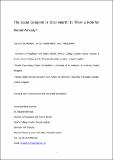Files in this item
The social gradient in oral health : is there a role for dental anxiety?
Item metadata
| dc.contributor.author | Bernabé, Eduardo | |
| dc.contributor.author | Humphris, Gerry | |
| dc.contributor.author | Freeman, Ruth | |
| dc.date.accessioned | 2018-03-28T23:33:43Z | |
| dc.date.available | 2018-03-28T23:33:43Z | |
| dc.date.issued | 2017-08 | |
| dc.identifier | 249229215 | |
| dc.identifier | 47027eeb-0ae7-4395-84d4-f8768a953f30 | |
| dc.identifier | 85017097328 | |
| dc.identifier | 000406975700009 | |
| dc.identifier.citation | Bernabé , E , Humphris , G & Freeman , R 2017 , ' The social gradient in oral health : is there a role for dental anxiety? ' , Community Dentistry and Oral Epidemiology , vol. 45 , no. 4 . https://doi.org/10.1111/cdoe.12297 | en |
| dc.identifier.issn | 0301-5661 | |
| dc.identifier.other | ORCID: /0000-0002-4601-8834/work/64033904 | |
| dc.identifier.uri | https://hdl.handle.net/10023/13043 | |
| dc.description.abstract | Objective : To evaluate the contribution of dental anxiety to social gradients in different oral health outcomes and whether social gradients in oral health persist once dental anxiety is removed from the population examined. M ethods : Data from 9035 British adults were analysed. Participants’ socioeconomic position (SEP) was measured through education and household income. Dental anxiety was measured with the Modified Dental Anxiety Scale. Poor subjective oral health, oral impacts on quality of life and edentulism among all adults and the number of teeth, DMFS and sextants with pocketing among dentate adults were the oral health outcomes. The contribution of dental anxiety to absolute and relative social inequalities in each oral health outcome (measured with the Slope and Relative Index of Inequality [SII and RII], respectively) was estimated from regression models without and with adjustment for dental anxiety and quantified with the percentage attenuation. Interactions between each SEP indicator and dental anxiety were used to test what would happen if dental anxiety were removed from the whole population. Results : The largest contribution of dental anxiety to explaining oral health inequalities was found for education gradients in perceived outcomes (11-13%), but dental anxiety explained <4% of social gradients in edentulism. Among dentate adults, dental anxiety accounted for <5% and <7% of education and income gradients, respectively. Only four of the 24 interactions tested were statistically significant. Hence, the education- and income-based SII and RII for oral impacts were non-significant among anxiety-free adults but were significant at higher levels of dental anxiety. Conclusions : Little support was found for the role of dental anxiety in explaining social inequalities in various perceived and clinical oral health measures. Oral health inequalities were found among both non-dentally anxious and anxious participants. | |
| dc.format.extent | 122573 | |
| dc.language.iso | eng | |
| dc.relation.ispartof | Community Dentistry and Oral Epidemiology | en |
| dc.subject | Anxiety | en |
| dc.subject | Disparities | en |
| dc.subject | Psychosocial aspects of oral health | en |
| dc.subject | RA0421 Public health. Hygiene. Preventive Medicine | en |
| dc.subject | RC0321 Neuroscience. Biological psychiatry. Neuropsychiatry | en |
| dc.subject | RK Dentistry | en |
| dc.subject | 3rd-DAS | en |
| dc.subject | SDG 3 - Good Health and Well-being | en |
| dc.subject.lcc | RA0421 | en |
| dc.subject.lcc | RC0321 | en |
| dc.subject.lcc | RK | en |
| dc.title | The social gradient in oral health : is there a role for dental anxiety? | en |
| dc.type | Journal article | en |
| dc.contributor.institution | University of St Andrews. School of Medicine | en |
| dc.contributor.institution | University of St Andrews. WHO Collaborating Centre for International Child & Adolescent Health Policy | en |
| dc.contributor.institution | University of St Andrews. Health Psychology | en |
| dc.contributor.institution | University of St Andrews. St Andrews Sustainability Institute | en |
| dc.contributor.institution | University of St Andrews. Population and Behavioural Science Division | en |
| dc.identifier.doi | https://doi.org/10.1111/cdoe.12297 | |
| dc.description.status | Peer reviewed | en |
| dc.date.embargoedUntil | 2018-03-28 |
This item appears in the following Collection(s)
Items in the St Andrews Research Repository are protected by copyright, with all rights reserved, unless otherwise indicated.

